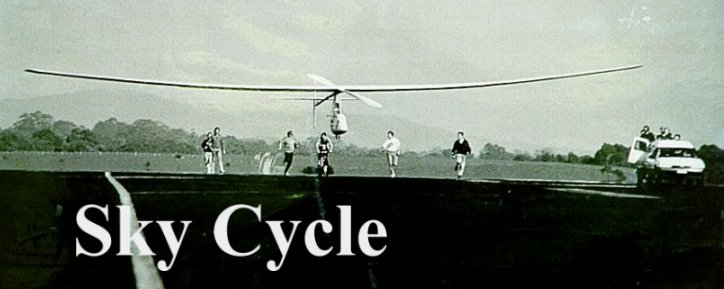

In the early morning of 4th October, 1991, Susan Gray powers the Sky Cycle into the air for a flight of nearly 200 metres, while the attention of the entire Sky Cycle team was focussed on the historic feat of a brave young lady.
I'm sure many of you have been approached and asked something like, "..... I hear that you fly radio control aeroplanes. Would you mind giving me a hand to get mine going?"
Well, when I received a phone call early in May, 1991, asking if I would be interested in trying to fly a human-powered aeroplane by radio control, I found it hard to believe. Trying not to sound too excited I said, "Yes", and so started my official involvement with quite an amazing project.
The driving force behind the project is Ron Sushames, a man of
vision and unquenchable energy. Ron is a senior teacher of
engineering at the Burnie TAFE College in Tasmania. He is a firm
believer in using full size working models to impart an
understanding of the subject being taught. In this case, subjects
such as structural analysis, CAD and other engineering units
seemed to demand of Ron that he should get his students involved
in the challenging project of building a human-powered aircraft.
Ron realised that it would not be an overnight wonder but would,
of necessity, be spread over a number of years. This has been the
case in reality, as trying to integrate initial design time,
building sessions, suitable flying weather, student holidays,
exams, repairs and redesign work has taken eight and a half years
so far.
However, the enthusiasm of Ron, and that of many of the students involved in the programme, has not flagged. There was one major set-back in October 1990 when the craft was damaged whilst undergoing initial flight tests. It was being towed behind a car when the right wingtip tucked under due to lack of rigidity to withstand torsion produced by aileron application. Fortunately the pilot, local bi-athlete Susan Grey, was not injured. The flying speed was approximately 25 km/h and the crash seemed to happen in slow motion.
Ron realised that the female pilots would be putting in a
tremendous physical effort trying to power the craft into the air,
and it would be asking too much of them to concentrate on the
additional task of learning to fly a largely untried and
untrimmed aeroplane. (The girls are not experienced flyers of any
type of aircraft.) He decided that he might have more chance of
achieving enough flying time to make valid observations regarding
necessary improvements if he could somehow separate the powering
and steering operations. Ron has always been interested in models,
and had been dabbling with RC helicopters for many years. In fact,
I first became acquainted with Ron through model helicopters
about 10 years ago, but had lost contact.
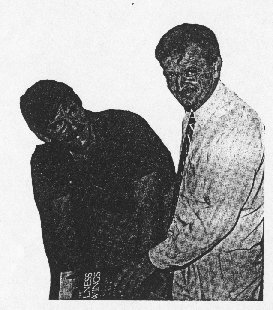 Anyway,
that brings us to the point when Ron got in touch with me about
the possibility of flying the Sky Cycle by remote control. I had
seen a very short TV news clip about the project so knew of its
existence, but had not seen it. After watching Paul McCready's
Gossomer Albatross fly the English Channel, and then the Daedalus
set the world record for a man-powered aircraft, of 117 km, by
flying from Crete to the island of Santorini across the Aegean in
1988, it was a dream come true to actually be involved with such
a project.
Anyway,
that brings us to the point when Ron got in touch with me about
the possibility of flying the Sky Cycle by remote control. I had
seen a very short TV news clip about the project so knew of its
existence, but had not seen it. After watching Paul McCready's
Gossomer Albatross fly the English Channel, and then the Daedalus
set the world record for a man-powered aircraft, of 117 km, by
flying from Crete to the island of Santorini across the Aegean in
1988, it was a dream come true to actually be involved with such
a project.
Hal Youngren, left, from the
famous Daedalus team, with Ron Sushames at the Burnie TAFE during
a visit in 1992. Hal made a slide presentation of the Daedalus
project, and captivated his audience.
Most of the time taken up by projects such as Gossamer, Daedalus
and Sky Cycle is spent upon design, analysis and re-design.
There have been three pilots to date; all girls. The reason
for having female pilots is that the various existing records set
by male pitots are considered to be beyond the scope of the
project at this stage, but the existing flights by within the
realms of possibility. female pilots are The present female world
Daedalus team in January 1987, record distance is 6.83 km (set by
Lois McCallin of the early using the Michelob Light Eagle, a fore-runner
of the official Australian record for any Daedalus design). At
present there is no distance for either male or female pilots. I
know that Lauchlan Thornpson was involved with building a copy of
Paul McCready's Gossomer Dragonfly with students at RMIT in 1979,
and achieved some flights, but to my knowledge no official record
attempt was made. (I believe that LSF member, John Lynch of
Tocumwal, NSW was also involved with an HPA canard project some
years ago when he was in the services, but he me that it did not
achieve much success, due to pitching problems.)
Since the beginning of the project, Ron and his students have
built the following:
3 cockpits; 7 seats; 2 fuselage booms; 3 complete wing sets; 3
tailplanes; 6 rudders; 1 propeller; 4 main undercarriages; 2
drive mechanisms; 1 very large trailer, modified twice; plus many
other little incidental objects too numerous to mention.
The RC set-up has basically remained the same throughout: 5 cell, 1700 mAh airborne battery, Tartan 12 kg-cm torque, 1/4 scale sized servos for surface controls, one servo for each aileron, one for elevator and two for rudder. The servos, receiver, various glues and some of the covering material were generously supplied by Tony Farnan of Model Engines at very reduced cost. I use my JR MC 16 transmitter for storing the trim settings, and so far we have had no problems with the control set-up except for the necessity to use 5 cells to allow for voltage drop along the long servo leads. It was found to be necessary to couple two servos together to provide enough torque to control the rudder adequately, as under cross-vand conditions we had experienced overpowering of the rudder. In one instance this initiated a massive ground loop on the runway. To see a 28 metre wingspan plane ground looping is quite an unnerving and unstoppable experience, I can assure you!
The craft is flown in the early morning hours at Wynyard airport
along the north west coast of Tasrnania. We actually fly off a
disused runway that parallels the main runway, and we often have
to halt proceedings while small private aircraft or one of
Kendall Airlines' passenger planes fly in or out. The passengers
have quite surprised expressions on their faces. The early
morning times are necessary to obtain the cold (freezing), still,
dense air necessary for flight. Being on the verge between not
flying and actually achieving flight, the craft is very sensitive
to atmospheric conditions. Even now, four years into its flight
development, as the air warms up the air density is reduced to
the point where flight cannot be sustained.
The initial design parameters were set by two aerospace engineers, Lauchlin Thompson and Mike Ellinas, of Aerospace Technologies Australia. The construction and subsequent design modifications have all taken place in Tasmania.
Lauchlin was responsible for the propeller design. He wrote a
computer program to analyse its design and performance according
to the Larrabee Vortex Theory. The calculations claim 89%
efficiency for the propeller design, and it must be working at
near this value to be getting our present results. The propeller
is designed to turn at 120 rpm, whilst the pilots generally work
at a cadence of about 80 rpm, necessitating a 1.5 to 1 speed
increase in the gearing ratio.
Mike did much of the work on the wing in terms of bending
moment analysis and shear stress calculations to obtain the spar
dimensions required. The wing spar is amazingly strong and has
withstood some tremendous loads in ground-looping situations.
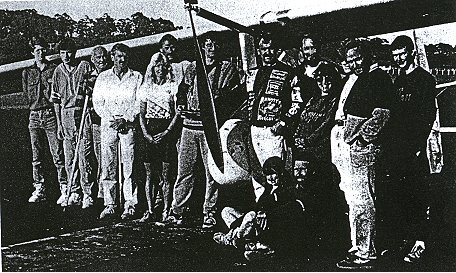
Some of the Sky Cycle team in 1992. Left to right: G. Kulpers, D.
Jones, J. Simmons,
R. Sushames (project co-ordinator), M. Taylor (pilot), M. Taylor,
C. Barrenger (RC pilot),
M. Crawford, K. Brooks, L. Deacon (obscured), D. Kirkham, J.
Simpson (seated), S. Gray
(pilot) and J. Mcleod. A brilliant achievement for all involved.
All major stress bearing structures are formed from carbon fibre. Fibreglass (2 layers of 4 oz) was used for the cockpit tub shell and kevlar thread was used as internal diagonal bracing ties in the wings. Covering material was 3 mm foam sheet for the leading edge surfaces of the flying surf aces, with the rear upper wing surf ace covered in 1.6 mm foam, and the lower rear 60% wing covered in clear mylar. Profilm was used to cover the rear open surfaces of the cockpit, and the windscreen was clear mylar. Epoxy glues were used in all spar constructions, and PVA was used for wood and foam contacts. The foam sheeting used for the wing coverings was attached using doubled-sided tape; it provided an excellent, quick and light bond!
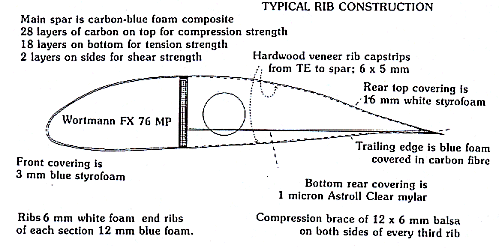
The propeller is hollow; balsa ribbed and balsa skinned, covered
in 3/4 oz glass cloth. The two propeller halves are attached to a
chrome-molybdenum tube as for an electric powered model. Variable
pitch control is available via a cable in the cockpit for pilot
use during flight.
The wing ribs are 6 mm foam capped in 0.5 mm hardwood veneer,
glued with PVA. The wing spars are of rectangular cross-section,
foam core wrapped in carbon fibre, the resin laid in by hand. The
root dimensions are 190 x 25 mm, and the tip dimensions are 65 x
25 mm. The wing trailing edge is foam with some carbon fibre
sheeting.
The fuselage boom and cockpit frames are of prepreg (vinyl ester resin) carbon fibre cylindrical booms made over a mandrill, heated in an oven at 150 degrees C for 1 1/2 hours, and pressed off with about 2 tonnes pressure! The mandrill is sprayed with 'Pure and Simple' and then waxed, 6 laminations of prepreg carbon fibre are spiral wound onto it at 45 degrees C, then it is wound with heat shrink tape and hung vertically in a specially made 5 metre cylindrical oven which resembles a wood heater flue.
The craft has only two wheels, and must be supported while
stationary on the ground by handlers on each wing and along the
boom. When ready to fly, the pilot begins to pedal slowly, and
the handlers give an initial push to get things going. (No
pushing is allowed for an official record attempt.) Communication
is possible between the pilot and Ron through voice activated
headsets. Ron travels in a chase car just off one wingtip.
1 fly the craft from the back of a ute travelling along just to the rear and off to one side of the craft. Unfortunately voice radio communication between me and the pilot has not been successful because of swamping interference from the transmitter.
Due to its light structure, the plane is rather flexible in flight. In dead calm conditions, control is gentle, yet positive. In turbulent air (more than 4 knots) or slight cross-wind conditions, control becomes difficult, especially on ailerons. The craft's light weight and huge wing span allow it to be easily pushed off course, and it takes a long time to counter such effects. It becomes rather like flying a plane which has all its controls hooked up with rubber band cables; a pull-it-and-sce-if-you-get-a-reaction type of effect. 1 must confess that it is a little scary to fly, but it is quite exhilarating!
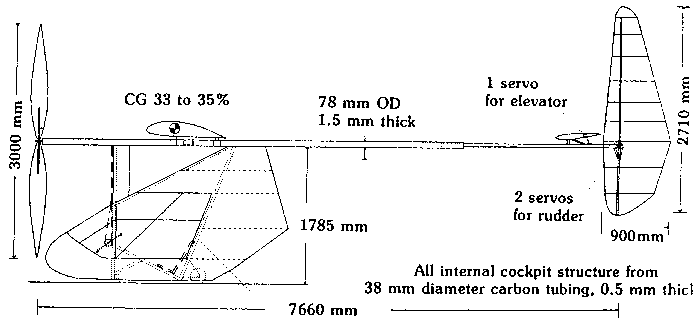
Amanda Smith (1990 to 1991)
Susan Gray (1990 onwards)
Marion Taylor (1992 onwards)
1985
Initial research into design work was undertaken.
1988 & 1989
The design details were transformed into working drawings by
computer. Construction began.
1990
The first prototype was completed about mid-year. It had detached
ailerons and internal cable controls for the pilot. Cautious
towing trials began. It crashed whilst being towed, from about 4
metres altitude, in October, due to aileron flutter and the right
wing tip tucking under.
1991
The first half of the year involved a rethink of the design
details and a rebuild. The wingspan was increased to 25 metres
and inset ailerons were added. A change was made to an all flying
tailplane. It was decided to include RC equipment for directional
control by an external pilot standing in the back of a following
vehicle. Contact was made about flying it by RC, with the first
testing in July. The best flight achieved was about 190 metres,
after much pushing. There were about two outings made during the
year.
1992
Design changes continued, allowing only one test outing, in early
June. A best flight of about 300 metres was achieved. Sustained
flight was still not really possible.
In late 1992 the craft was exhibited at the Avalon Air Show where
it made a few short demonstration hops. We used rudder design
number 5 there; each successive one had been getting bigger.
Number 5 gave enough directional control in slightly turbulent
air, however, we had to add another servo to provide enough power
to stop the wind from overpowering it in certain situations.
1993
A new fuselage boom and cockpit were made to save weight and to
improve pilot comfort. The wingspan was increased to 28 metres
with the addition of wingtip extensions. The drive was changed
from direct gear drive to a chain drive system. We had been
experiencing a lot of power loss in the drive system and the
improvement given by the chain drive was found to be enormous.
All these changes resulted in a most successful test outing on
lst June, 1993, when two flights of 800 metres each were made
straight after each other. The flights could have been longer
except that we ran out of runway!. This was the first evidence of
sustainable flight.
Results were so encouraging that the steps required for making an
official attempt have been put into action and, depending on
suitable conditions, the plan is to go for an Australian record
later this year.
Since the last flight mentioned, a few changes to the main wheel
and the pedals have resulted in a weight saving of a further 500
grams, and rudder design number 6 is ready. (This is only a
slight alteration to the lower area of the rudder to help balance
it dynamically, as its application was introducing a torque which
caused the boom to rotate and hence interfere with elevator and
rudder control.) 
Sky Cycle sits on the Wynyard runway in the early morning light.
Wing droop is small despite
lack of external bracing. This whole aircraft weighs only 38 kg!
A brief history of hurnan-powered world records is given below.
This was taken from an official fax from the FAI. It is
interesting to note that the record is held by the pilot, not the
country of origin of the plane.
Date |
Name & Aircraft |
Span |
Area |
Category |
Place |
| 12.6.'79 | Bryan Alien, USA, Gossamer Albatross | 28.6 | 44 | Male, Duration - 2 h 49 min Distance (st. line) - 35.82 km |
English Channel |
| 2.10.'85 | Holger Rocheit, FRG Muscular 2 | 19.5 | 11.9 | Male Speed closed circuit 44.32 km/h |
Triangular 1500 metre course |
| 2 1. l.'87 | Lois McCallin, USA Michelob Light Eagle |
34.75 | 35 | Female Distance (st. line) - 6.83 km Distance (closed ct.) - 15.44 km Duration - 37 min 38 sec |
Rogers Dry Lake California |
| 2 2. l.'87 | Glen Trernmi, USA Michelob Light Eagle |
34.75 | 35 | Male Distance (closed circuit) 58.66 km |
Rogers Dry Lake California |
| 23.4.'88 | K. Kanellopoulos Greece Daedalus 88 |
34.75 | 35 | Male Distance (st. line) - 115.108 km Duration - 3 hr 54 min 59 sec |
Crete to Santorini |
Triumph late in 1991. Sky Cycle aloft with Sue Gray in the cockpit. On the push bike. J. Simpson. Runners: D. Quinn, D. Jones and B. Armstrong. Chris has the radio control transmitter in the trailer behind the panel van. The runners commented on the wonderful feeling of being so close and hearing the aircraft fly.
Apologies for the quality of some of these pics and drawings but I haven't had access to the originals as yet. Clicking on some pics will go to a much larger view.
Article taken from the Aeromodelling Digest 1993
ISSN 1039 . 9224
Published by Samaria Concepts,
RMB 1798, Benalla, Victoria, 3673. Telephone (057) 67 2322
Printed by Pryor Printing Service, Wangaratta, Victoria.
Typesetting by Barinore Productions, Benalla, Victoria.
Artwork by Samaria Concepts.
Compiled and Edited by M. and J.M. Buckmaster.
Copyright Samaria Concepts 1993.
No part of this publication may be reproduced in any form except
with permission from the publisher.
Plans used to illustrate the construction articles In this
Digest were photo reduced in size by
Albertos Plan Printing, 520 Flinders Street, Melbourne, 3000
Also published by Samaria Concepts: Aeromodelling Digest 1990, Aeromodelling Digest 1991, Aeromodelling Digest 1992 & Glossary for Aeromodellers.